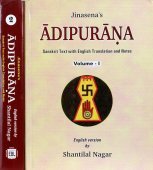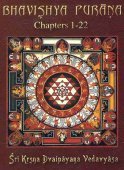Brahmapurana, Brahmapurāṇa, Brahma-purana, Brahman-purana: 15 definitions
Introduction:
Brahmapurana means something in Hinduism, Sanskrit. If you want to know the exact meaning, history, etymology or English translation of this term then check out the descriptions on this page. Add your comment or reference to a book if you want to contribute to this summary article.
In Hinduism
Purana and Itihasa (epic history)
Source: archive.org: Puranic EncyclopediaBrahmapurāṇa (ब्रह्मपुराण).—(brāhmapurāṇa) This is a great book of twenty-five thousand verses taught to the great hermit-sage Marīci by Brahmā. It is mentioned in Agni Purāṇa, Chapter 271, that if a copy of this book is taken and offered to a Brahmin on the full moon day of the month of Vaiśākha with cow and water, the giver will attain heaven.
Source: Cologne Digital Sanskrit Dictionaries: The Purana IndexBrahmapurāṇa (ब्रह्मपुराण).—The Purāṇa containing 10, 000 stanzas.*
- * Vāyu-purāṇa 104. 6.
Brāhmapurāṇa (ब्राह्मपुराण).—Also Brāhmam; one of the eighteen mahāpurāṇas; comprises 10,000 ślokas;1 with 30,000 ślokas; he who writes this and makes a gift of it in the Vaiśāka, Full Moon day, attains Brahmaloka;2 the First purāṇa.3
Source: Shodhganga: Elements of Art and Architecture in the Trtiyakhanda of the VisnudharmottarapuranaBrahmapurāṇa (ब्रह्मपुराण) refers to one of the eighteen Major Puranas according to the Matsyapurāṇa and other traditional lists of Puranic literature: a category of ancient Sanskrit texts which gives a huge contribution in the development of Indian literature.—The lists of eighteen Mahāpurāṇas (e.g., brahmapurāṇa) and eighteen Upapurāṇas are not same everywhere, as some names are dropped in some references whereas some are included in others. It can be noticed that, except the Vāyuapurāṇa and the Śivapurāṇa, the names of the Mahāpurāṇas are similar in almost all the Purāṇas.

The Purana (पुराण, purāṇas) refers to Sanskrit literature preserving ancient India’s vast cultural history, including historical legends, religious ceremonies, various arts and sciences. The eighteen mahapuranas total over 400,000 shlokas (metrical couplets) and date to at least several centuries BCE.
Dharmashastra (religious law)
Source: Shodhganga: The saurapurana - a critical study (dharma)Brahmapurāṇa (ब्रह्मपुराण) should be donated (dāna) on the fourteenth tithi according to the Dharmaśāstra taught in the 10th century Saurapurāṇa: one of the various Upapurāṇas depicting Śaivism.—Accordingly, the donation of the various Purāṇas to various recipients on different tithis along with the merits thereof are given in the ninth chapter.—[...] It is stated that if a person donates the Brahmapurāṇa with devotion to a Brahmin devotee of Śiva on the fourteenth tithi gets release from all sins.

Dharmashastra (धर्मशास्त्र, dharmaśāstra) contains the instructions (shastra) regarding religious conduct of livelihood (dharma), ceremonies, jurisprudence (study of law) and more. It is categorized as smriti, an important and authoritative selection of books dealing with the Hindu lifestyle.
General definition (in Hinduism)
Source: Oxford Reference: A Dictionary of HinduismClassified as one of the eighteen ‘great Purāṇas’ (mahāpurāṇas) in the rājasa group, i.e. those said to relate to Brahmā, much of it actually seems to relate to the worship of Kṛṣṇa (as Jagannātha) in Orissa; it also contains Śaiva, Vaiṣṇava, and Saura oriented material. Despite one of its names, it is a relatively late text, which borrows heavily from other Purāṇas and the Harivaṃśa.
Source: Shodhganga: Introduction to PurāṇasThe Brahmapurāṇa is the first of the eighteen Purāṇa. The Brahmapurāṇa may be regarded as the earliest of the series, at least in the estimation of the writers of the Purāṇa. According to Balambhaṭṭa, it is consequently known by the name of Ādi or First Purāṇa. It is said to contain 245 adhyāyas and twentyfive thousand verses. Dr. Wilson opines that the actual number is about seven thousand five hundred.
The verses of the Brahmapurāṇa, forming an address to Hari and puruṣottama, clearly declare its sectarial character and indicate it to be a Vaiṣṇava work. It does not figure in the list of Vaiṣṇavapurāṇas as given by the Padmapurāṇa but is referred to in the Śākta class, in which the worship of Śakti, the personified female principle, is more particularly inculcated, and in which Rajas (passion) is predominant.
Source: WikiPedia: HinduismThe Brahma Purana (ब्रह्म पुराण) is one of the eighteen major Puranas genre of Hindu texts in Sanskrit language. Another title for this text is Saura Purana, because it includes many chapters related to Surya or the Sun god. It is divided into two parts: the Purvabhaga (former part) and the Uttarabhaga (later part)
The text is notable for dedicating over 60% of its chapters on description of geography and holy sites of Godavari river region, as well as places in and around modern Odisha, and tributaries of Chambal river in Rajasthan. This travel guide-like sections are non-sectarian, and celebrates sites and temples related to Vishnu, Shiva, Devi and Surya. The coverage of Jagannatha (Krishna, Vishnu-related) temples, however, is larger than the other three.
Languages of India and abroad
Sanskrit dictionary
Source: DDSA: The practical Sanskrit-English dictionaryBrahmapurāṇa (ब्रह्मपुराण).—Name of one of the eighteen Purāṇas.
Derivable forms: brahmapurāṇam (ब्रह्मपुराणम्).
Brahmapurāṇa is a Sanskrit compound consisting of the terms brahman and purāṇa (पुराण).
Source: Cologne Digital Sanskrit Dictionaries: Cappeller Sanskrit-English DictionaryBrahmapurāṇa (ब्रह्मपुराण).—[neuter] T. of Purāṇa.
Source: Cologne Digital Sanskrit Dictionaries: Aufrecht Catalogus Catalogorum1) Brahmapurāṇa (ब्रह्मपुराण) as mentioned in Aufrecht’s Catalogus Catalogorum:—styled also ādipurāṇa Io. 647. 1314. Oxf. 17^b. 20^a. Paris. (B 24. Tel. 17 Uttarakhaṇḍa). L. 1182. Khn. 28. K. 26. B. 2, 14. Report. V. Bih. 187. 188. Kāṭm. 2. Rādh. 39. Oudh. Viii, 4. Xv, 20. Np. V, 10. Burnell. 189^a. Bhk. 13. Poona. Ii, 223. Oppert. Ii, 4770. Rice. 72. Sb. 229. Mentioned in Kūrmapurāṇa Oxf. 8^a, in Vāmanapurāṇa Oxf. 45^b, in Varāhapurāṇa Oxf. 59^a, in Revāmāhātmya Oxf. 65^a, in Devībhāgavatapurāṇa Oxf. 79^b. Hemādri in Pariśeṣakhaṇḍa 1, 1552. 1553. 1556 quotes an Ādya Brahmapurāṇa. Brahmapurāṇe Ṛṣipañcamīvrata. Sb. 130.
—Kalāhastimāhātmya. Burnell. 189^a.
—Kodaṇḍamaṇḍana. Burnell. 189^a.
—Godāvarīmāhātmya. Poona. 551.
—Gautamīgaṅgāmāhātmya. Bhk. 14.
—Gautamīmāhātmya. Burnell. 189^a. Poona. 457.
—Campāṣaṣṭhīvratakathā. Peters. 1, 115.
—Nāsikopākhyāna i. e. Nāciketopākhyāna. Khn. 28.
—Puruṣottamamāhātmya. Khn. 28.
—Prayāgamāhātmya. Burnell. 189^a. Bhr. 553.
—Kṣetrakhaṇḍe Mallārimāhātmya. Khn. 28.
—Māyāpurīmāhātmya. Bhk. 15.
—Rāmasahasranāman. Paris. (D 5).
—Lalitākhaṇḍa. Khn. 28.
—Lalitopākhyāna. Khn. 30. Burnell. 189^a.
—Veṅkaṭagirimāhātmya. Burnell. 189^a. Taylor. 1, 59.
—Śrīraṅganāthamāhātmya. Burnell. 189^a. Bhr. 554.
—Śvetagirimāhātmya. Burnell. 189^a.
—Sarasvatīstotra. Tu7b. 11.
—Hastigirimāhātmya. Kh. 32. Burnell. 189^a.
2) Brahmapurāṇa (ब्रह्मपुराण):—Stein 205. Brahmapurāṇe Karmavipākasaṃhitā. Stein 84.
—Gautamīmāhātmya. Fl. 22. Peters. 4, 13.
—Mallārimāhātmya. [Bhau Dāji Memorial] 86. Peters. 4, 14.
—Mārtaṇḍamāhātmya. Stein 205.
3) Brahmapurāṇa (ब्रह्मपुराण):—Ulwar 805.
Brahmapurāṇa has the following synonyms: Ādipurāṇa.
4) Brahmapurāṇa (ब्रह्मपुराण):—As p. 122. Bc 192 (Uttarakhaṇḍa). Cs 4, 54 (inc.). Io. 647. 1314 (both Pūrvakhaṇḍa). 2845 ([fragmentary]). Tod 12 (not quite finished). Brahmapurāṇe Gautamīmāhātmya. Io. 2549. 2677.
—Janmāṣṭamīvrata. L.. 232.
—Budhāṣṭamīvrata. Cs 2, 261. 603.
—Bhāratavarṣavivaraṇa. Cs 4, 55.
—Maṇimaṇḍapamāhātmya. Io. 2618. No. 3409.
—Lakṣmīsahasranāman. L.. 233. 234, 3 (inc.). Peters. 5, 195.
—Sūryacandraparvakathā. L.. 1235.
—Hastigirimāhātmya (Adhyāyāḥ 1-15). Winternitz Catal. p. 238.
1) Brahmapurāṇa (ब्रह्मपुराण):—[=brahma-purāṇa] [from brahma > brahman] n. Name of one of the 18 Purāṇas (also called ādi-p; it is supposed to have been revealed by Brahmā to Dakṣa, and its main object appears to be the promotion of the worship of Kṛṣṇa), [Indian Wisdom, by Sir M. Monier-Williams 514.]
2) Brāhmapurāṇa (ब्राह्मपुराण):—[=brāhma-purāṇa] [from brāhma > brahman] n. = brahma-p, [Viṣṇu-purāṇa]
[Sanskrit to German]
Sanskrit, also spelled संस्कृतम् (saṃskṛtam), is an ancient language of India commonly seen as the grandmother of the Indo-European language family (even English!). Closely allied with Prakrit and Pali, Sanskrit is more exhaustive in both grammar and terms and has the most extensive collection of literature in the world, greatly surpassing its sister-languages Greek and Latin.
Kannada-English dictionary
Source: Alar: Kannada-English corpusBrahmapurāṇa (ಬ್ರಹ್ಮಪುರಾಣ):—[noun] one of the eighteen purāṇas, supposed to have been revealed by Brahma to Dakṣa.
Kannada is a Dravidian language (as opposed to the Indo-European language family) mainly spoken in the southwestern region of India.
See also (Relevant definitions)
Partial matches: Brahman, Brahma, Purana, Puraana.
Full-text (+530): Adipurana, Gatralata, Jayada, Vaishakapurnima, Mriganetra, Gajara, Tottala, Mayati, Carvya, Upapatha, Karatha, Surashreshtha, Navani, Tamsurodha, Kalandara, Yungin, Kankalin, Janmejaya, Dalbhyaka, Sarvarakshana.
Relevant text
Search found 35 books and stories containing Brahmapurana, Brahma-purāṇa, Brahmapurāṇa, Brahma-purana, Brahman-purana, Brahman-purāṇa, Brāhmapurāṇa, Brāhma-purāṇa; (plurals include: Brahmapuranas, purāṇas, Brahmapurāṇas, puranas, Brāhmapurāṇas). You can also click to the full overview containing English textual excerpts. Below are direct links for the most relevant articles:
Settlement in Early Historic Ganga Plain (by Chirantani Das)
Part 6 - Rājagṛha supreme seat (a): King Jarāsandha < [Chapter II - Origin and Function of Rājagṛha as the seat of Monarchy]
Part 3 - Rivers and other water sources of Vārāṇasī < [Chapter V - Rise of Vārāṇasī as a Nodal Centre]
Part 16 - Vārāṇasī from proto historic to historic context < [Chapter VI - Vārāṇasī: Emergence of the Urban Centre and Seat of Administration]
Historical Elements in the Matsya Purana (by Chaitali Kadia)
Date of the Purāṇas < [Chapter 1 - An Introduction of the Purāṇas]
Subject matter of the Purāṇas < [Chapter 1 - An Introduction of the Purāṇas]
The concept of Bhāratavarṣa < [Chapter 4 - Geographical history in the Matsya-Purāṇa]
The Vishnu Purana (by Horace Hayman Wilson)
1. The Brahmā Purāṇa < [Preface]
Chapter XVI - Dynasty of Turvasu < [Book IV]
Chapter XIII - Posterity of Dhruva < [Book I]
Cosmetics, Costumes and Ornaments in Ancient India (by Remadevi. O.)
1.2. Materials (q): Syamantaka < [Chapter 3 - Ornaments]
Animal Kingdom (Tiryak) in Epics (by Saranya P.S)
Related products


